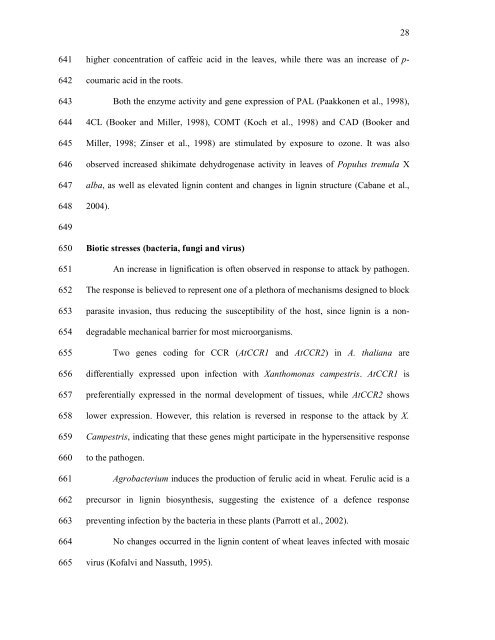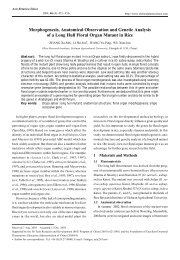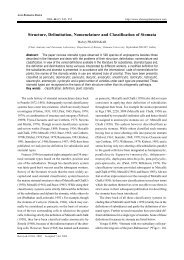Abiotic and biotic stresses and changes in the lignin ... - ResearchGate
Abiotic and biotic stresses and changes in the lignin ... - ResearchGate
Abiotic and biotic stresses and changes in the lignin ... - ResearchGate
You also want an ePaper? Increase the reach of your titles
YUMPU automatically turns print PDFs into web optimized ePapers that Google loves.
28<br />
641<br />
642<br />
643<br />
644<br />
645<br />
646<br />
647<br />
648<br />
higher concentration of caffeic acid <strong>in</strong> <strong>the</strong> leaves, while <strong>the</strong>re was an <strong>in</strong>crease of p-<br />
coumaric acid <strong>in</strong> <strong>the</strong> roots.<br />
Both <strong>the</strong> enzyme activity <strong>and</strong> gene expression of PAL (Paakkonen et al., 1998),<br />
4CL (Booker <strong>and</strong> Miller, 1998), COMT (Koch et al., 1998) <strong>and</strong> CAD (Booker <strong>and</strong><br />
Miller, 1998; Z<strong>in</strong>ser et al., 1998) are stimulated by exposure to ozone. It was also<br />
observed <strong>in</strong>creased shikimate dehydrogenase activity <strong>in</strong> leaves of Populus tremula X<br />
alba, as well as elevated lign<strong>in</strong> content <strong>and</strong> <strong>changes</strong> <strong>in</strong> lign<strong>in</strong> structure (Cabane et al.,<br />
2004).<br />
649<br />
650<br />
651<br />
652<br />
653<br />
654<br />
655<br />
656<br />
657<br />
658<br />
659<br />
660<br />
661<br />
662<br />
663<br />
664<br />
665<br />
Biotic <strong>stresses</strong> (bacteria, fungi <strong>and</strong> virus)<br />
An <strong>in</strong>crease <strong>in</strong> lignification is often observed <strong>in</strong> response to attack by pathogen.<br />
The response is believed to represent one of a plethora of mechanisms designed to block<br />
parasite <strong>in</strong>vasion, thus reduc<strong>in</strong>g <strong>the</strong> susceptibility of <strong>the</strong> host, s<strong>in</strong>ce lign<strong>in</strong> is a nondegradable<br />
mechanical barrier for most microorganisms.<br />
Two genes cod<strong>in</strong>g for CCR (AtCCR1 <strong>and</strong> AtCCR2) <strong>in</strong> A. thaliana are<br />
differentially expressed upon <strong>in</strong>fection with Xanthomonas campestris. AtCCR1 is<br />
preferentially expressed <strong>in</strong> <strong>the</strong> normal development of tissues, while AtCCR2 shows<br />
lower expression. However, this relation is reversed <strong>in</strong> response to <strong>the</strong> attack by X.<br />
Campestris, <strong>in</strong>dicat<strong>in</strong>g that <strong>the</strong>se genes might participate <strong>in</strong> <strong>the</strong> hypersensitive response<br />
to <strong>the</strong> pathogen.<br />
Agrobacterium <strong>in</strong>duces <strong>the</strong> production of ferulic acid <strong>in</strong> wheat. Ferulic acid is a<br />
precursor <strong>in</strong> lign<strong>in</strong> biosyn<strong>the</strong>sis, suggest<strong>in</strong>g <strong>the</strong> existence of a defence response<br />
prevent<strong>in</strong>g <strong>in</strong>fection by <strong>the</strong> bacteria <strong>in</strong> <strong>the</strong>se plants (Parrott et al., 2002).<br />
No <strong>changes</strong> occurred <strong>in</strong> <strong>the</strong> lign<strong>in</strong> content of wheat leaves <strong>in</strong>fected with mosaic<br />
virus (Kofalvi <strong>and</strong> Nassuth, 1995).







